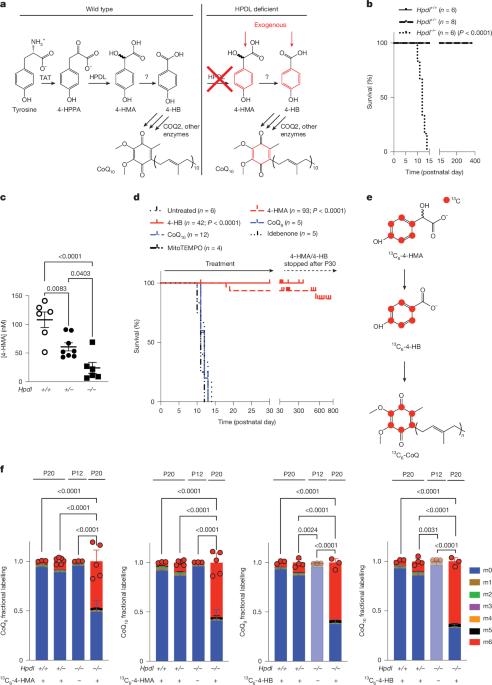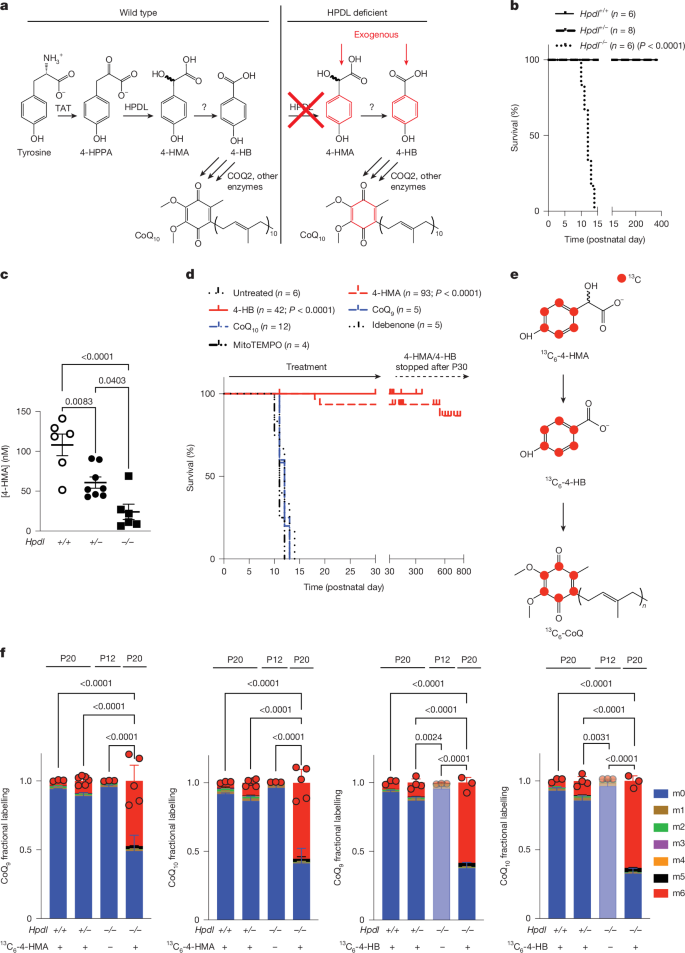Coenzyme Q headgroup intermediates can ameliorate a mitochondrial encephalopathy
IF 48.5
1区 综合性期刊
Q1 MULTIDISCIPLINARY SCIENCES
引用次数: 0
Abstract
Decreased brain levels of coenzyme Q10 (CoQ10), an endogenously synthesized lipophilic antioxidant1,2, underpin encephalopathy in primary CoQ10 deficiencies3,4 and are associated with common neurodegenerative diseases and the ageing process5,6. CoQ10 supplementation does not increase CoQ10 pools in the brain or in other tissues. The recent discovery of the mammalian CoQ10 headgroup synthesis pathway, in which 4-hydroxyphenylpyruvate dioxygenase-like protein (HPDL) makes 4-hydroxymandelate (4-HMA) to synthesize the CoQ10 headgroup precursor 4-hydroxybenzoate (4-HB)7, offers an opportunity to pharmacologically restore CoQ10 synthesis and mechanistically treat CoQ10 deficiencies. To test whether 4-HMA or 4-HB supplementation promotes CoQ10 headgroup synthesis in vivo, here we administered 4-HMA and 4-HB to Hpdl−/− mice, which model an ultra-rare, lethal mitochondrial encephalopathy in humans. Both 4-HMA and 4-HB were incorporated into CoQ9 and CoQ10 in the brains of Hpdl−/− mice. Oral treatment of Hpdl−/− pups with 4-HMA or 4-HB enabled 90–100% of Hpdl−/− mice to live to adulthood. Furthermore, 4-HB treatment stabilized and improved the neurological symptoms of a patient with progressive spasticity due to biallelic HPDL variants. Our work shows that 4-HMA and 4-HB can modify the course of mitochondrial encephalopathy driven by HPDL variants and demonstrates that CoQ10 headgroup intermediates can restore CoQ10 synthesis in vivo. Decreased brain coenzyme Q10 levels cause encephalopathy and are associated with neurodegeneration; supplementation with 4-HMA or 4-HB restores coenzyme Q10 synthesis in mice and humans with HPDL variants, improving survival and neurological symptoms in HPDL-driven mitochondrial encephalopathy.


辅酶Q头群中间体可以改善线粒体脑病
辅酶Q10 (CoQ10)是一种内源性合成的亲脂性抗氧化剂1,2,其脑内水平降低是原发性辅酶Q10缺乏的脑病3,4的基础,并与常见的神经退行性疾病和衰老过程5,6相关。补充辅酶q10不会增加大脑或其他组织中的辅酶q10库。最近发现的哺乳动物辅酶q10头群合成途径,其中4-羟基苯基丙酮酸双加氧酶样蛋白(HPDL)使4-羟基酸酯(4-HMA)合成辅酶q10头群前体4-羟基苯甲酸酯(4-HB)7,为药理学上恢复辅酶q10合成和机制上治疗辅酶q10缺乏提供了机会。为了测试补充4-HMA或4-HB是否能促进体内CoQ10头群的合成,我们给Hpdl - / -小鼠注射了4-HMA和4-HB, Hpdl - / -小鼠模拟了一种超罕见的、致命的人类线粒体脑病。在Hpdl−/−小鼠的大脑中,4-HMA和4-HB都被纳入CoQ9和CoQ10中。用4-HMA或4-HB口服Hpdl - / -幼崽使90-100%的Hpdl - / -小鼠活到成年。此外,4-HB治疗稳定并改善了由双等位基因HPDL变异引起的进行性痉挛患者的神经系统症状。我们的研究表明,4-HMA和4-HB可以改变由HPDL变体驱动的线粒体脑病的病程,并证明CoQ10头群中间体可以在体内恢复CoQ10的合成。
本文章由计算机程序翻译,如有差异,请以英文原文为准。
求助全文
约1分钟内获得全文
求助全文
来源期刊

Nature
综合性期刊-综合性期刊
CiteScore
90.00
自引率
1.20%
发文量
3652
审稿时长
3 months
期刊介绍:
Nature is a prestigious international journal that publishes peer-reviewed research in various scientific and technological fields. The selection of articles is based on criteria such as originality, importance, interdisciplinary relevance, timeliness, accessibility, elegance, and surprising conclusions. In addition to showcasing significant scientific advances, Nature delivers rapid, authoritative, insightful news, and interpretation of current and upcoming trends impacting science, scientists, and the broader public. The journal serves a dual purpose: firstly, to promptly share noteworthy scientific advances and foster discussions among scientists, and secondly, to ensure the swift dissemination of scientific results globally, emphasizing their significance for knowledge, culture, and daily life.
 求助内容:
求助内容: 应助结果提醒方式:
应助结果提醒方式:


